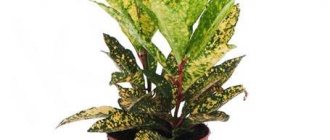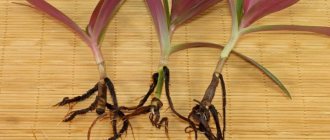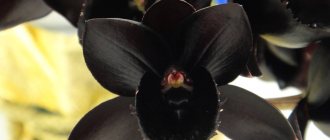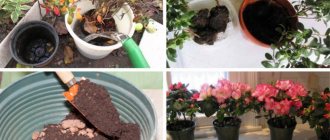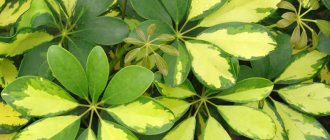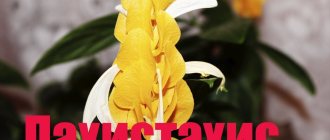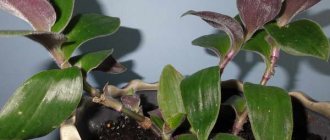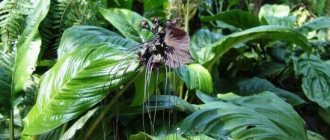Botanical description
Tradescantia (oysters, cradle lilies, spider lilies) belong to the Commelionaceae family and are classified as a separate genus consisting of 75 species. These are herbaceous perennials , the maximum height of which is 60 cm. The stems are most often creeping and thin.
They grow in groups or separately in fields and forests. The length, shape, and color of the foliage depend on the species (green or variegated). The surface of the plates may be pubescent.
The inflorescences are paniculate, the flowers (blue, violet, light blue, pink, white), consist of three petals and six stamens (sometimes four petals and eight stamens), close during the day in sunny weather. Each individual flower lives only one day , but the large number of buds ensures continuous flowering from spring to autumn. Tradescantia juice is clear and sticky.
The natural conditions of this plant are America (from Mexico to Canada). Species imported from the tropics are grown as indoor flowers. Suitable for open ground are varieties bred from Tradescantia growing in the north of the American continent, where they are called arachnids.
Tradescantia propagation
Tradescantia is propagated by seeds and cuttings.
Cuttings
The easiest and most convenient way to propagate Tradescantia is by cuttings. Its shoots quickly and easily produce roots and subsequently take root. In this way, Tradescantia can be propagated from early spring to late autumn, excluding only the winter months, when root formation is very slow. Young shoots of Tradescantia with a length of at least 15 cm are suitable for cuttings. They take root well in ordinary warm water at air temperatures above 20°C. After the roots appear, the cuttings are planted in the soil substrate in compliance with all the requirements for planting: drainage, optimal soil mixture, suitable pot volume, timely watering.
Planting several shoots in one pot at the same time gives the plant a special decorativeness and splendor.
Young shoots of Tradescantia with a length of at least 15 cm are suitable for cuttings.
Video: propagation of Tradescantia by cuttings
Seed propagation
Propagation of Tradescantia by seeds is not as popular as cuttings, but no less effective. It is often used for growing garden species. Planting the plant with seeds is carried out in the spring, usually in March. Seeds are planted in a prepared container with soil substrate (the best option would be a light and loose mixture of peat and sand in a 1:1 ratio) or in peat tablets. The soil should be moist, but not soggy. The seeds are scattered over the surface of the soil and slightly covered with the substrate on top. The container with seeds must be covered with plastic film or glass, creating the effect of a greenhouse with constant humidity and temperature. The emergence of seedlings should be expected no earlier than 2 weeks after planting. Subsequently, the seedlings are planted in separate pots. This procedure is carried out after the appearance of the third leaf.
Tradescantia grown from seeds will bloom 3 years after planting.
The appearance of the third leaf is a sign of Tradescantia’s readiness for transplantation.
What it looks like, what family it belongs to
Tradescantia is one of the most common indoor plants. Her flowers are small and modest. The fruits are small shaped capsules, each containing several seeds.
Tradescantia is grown in greenhouses and in open ground
The hanging plant is used for landscaping both brightly lit rooms and shaded rooms. Indoor Tradescantia looks good on high stands and in hanging flowerpots; it is used to decorate arches and niches. By combining different types, you can create hanging gardens, giving the indoor space a feeling of lightness and airiness.
Additional Information! Tsiolkovsky also spoke about the need to use plants on long flights to ensure breathing and nutrition for people. In 1960, plants made their first space flight, and Tradescantia was among them!
The chemical composition of the plant determines the ability to purify the air from harmful impurities and increase the humidity of the external environment. Phytoncides secreted by Tradescantia suppress the development of fungi and bacteria.
Tradescantia ampelous also has medicinal properties, which have long been noticed by traditional medicine. Diluted fresh juice is used for sore throats to gargle, and the decoction is used to rinse the nose. Tinctures are used to cleanse the intestines. In places where it grows naturally, the juice of the flower is used as a wound-healing agent, lubricating cuts and bruises.
Varieties and photos
Although tradescantia is sometimes considered a weed, at the moment they are quite popular ornamental plants that are grown indoors and outdoors (in containers, borders). The flower does not have a clear division into varieties for the garden and indoors. Any species can be planted in a flowerbed for the summer. Below are photos, names and descriptions of Tradescantia varieties suitable for propagation and care at home:
Zebrina
This species has purplish-violet stems, young erect, adults pendulous. The leaves are ovate with symmetrical silver stripes on the front side of the plates. The reverse side is purple. Small flowers are purple or violet . This species is bred indoors for its highly decorative foliage, as flowering is rarely observed.
Zebrina cleanses the air and releases antibacterial substances. Can replace aloe in the treatment of diseases caused by colds. In the photo below is the Tradescantia Zebrina variety:
Small-leaved
This species is the smallest and most delicate. There are a large number of small ovoid shiny leaves on the purple stems. The front surface of the plates is green, the reverse is purple. Indoors, the small-leaved plant grows very quickly and looks great in flowerpots. Reproduction and care do not create problems. Suitable for growing indoors with completely artificial lighting. The photo below shows Tradescantia small-leaved:
Nanook
This species has an unusual coloring. The shoots are creeping and quickly take root. The leaves are pointed, ovate, with a smooth surface and cream or pink stripes. The lower part of the plates is hairy and purple. In a pot, the width is up to 65 cm, the height is up to 40 cm. If the care is correct, beautiful white or pink flowers appear in warm weather. Nanook is suitable for growing on the balcony. You can see what the Tradescantia Nanuk variety looks like in the photo below:
White-flowered
This tradescantia is often called uridis or tricolor. It was brought from the south of America. The shoots are creeping, flexible, green or striped foliage is oval, elongated, glossy. The inflorescences are umbrella-shaped, the flowers are white and small. The best place is a room with windows facing east and west.
Varieties developed from this species:
- Tricolor with green leaves covered with white or pink stripes;
- Aurea with yellow foliage covered with green stripes;
- Laekenensis - leaves with pink stripes on a green background;
- Alba - leaves with white or green stripes on a light green background.
Varieties with striped foliage are best placed in the south.
Bedspread
Short stems (no longer than 40 cm) are straight and fleshy. The roots are small and located horizontally. The large lanceolate foliage is dense and forms rosette-like patterns. There are bluish stripes on the bright green front surface. The reverse side is purple-pink. Small white flowers appear rarely. Bedspread can be planted separately or together with large plants as a “edge”.
Virginskaya
This species has straight, branched stems, sessile leaves lanceolate or linear. The inflorescences at the tops are umbrella-shaped, dense, the flowers of three petals are pink-violet. Virginia blooms in July , producing capsule-shaped fruits. The most popular varieties bred from Virginia: coerulea with blue flowers, atrorubra with blood red flowers, rosea with pink flowers.
Anderson
The shoots are straight, branched, can grow up to 80 cm, the foliage with a purple tint is lanceolate and voluminous.
Umbrella inflorescences contain flat flowers, the colors of which depend on the variety:
- Osprey - snow-white;
- Leonora - blue-violet;
- Iris - blue, rich;
- Blue Stone - blue;
- Hutchinsonii – blue;
- Сoccinea – red;
- Carnea – pink.
All these varieties are bred for the garden.
Sillamontana
The height in the container is 20 cm, in the ground up to half a meter. The roots are superficial and dense. The young flower has straight green stems with a purple tint, while the adult has creeping stems. Oval foliage alternate, sessile, fleshy. The upper part of the plates is olive, with a silver tint, the lower part is purple with a violet tint. Peduncles are located in the axils, the flowers are purple and bright. Decorative effect does not depend on humidity.
Riverside (myrtle-leaved)
The purple stems are thin, fragile, the ovoid leaves are small (up to 2.5 cm long). The outer side of the plates is green, bright, the reverse is red with a purple tint. The most popular varieties: quicksilver - foliage with white stripes; variegata with cream.
Sitara ("women's gossip")
Varieties bred from this species are similar in appearance to dracaena and are grown indoors. Stems are straight, foliage is lanceolate. The outer side of the plates is green (less often yellow), the reverse side is red or purple. As the castings grow, they fall off at the bottom and a rosette forms at the top. The flowers are blue or purple, located at the tops of the shoots. Sitara is easy to care for (no experience in floriculture is required).
Description
Tradescantia is a perennial vine and has about a hundred varieties. The plant came to Europe thanks to the traveler John Tradescant, who was a gardener at the royal court of Great Britain. This unusual culture was named in his honor. As a rule, Tradescantia is grown as an indoor flower, but hybrids have been bred that take root well in open soil.
The colorful shoots of bright green color add a special charm to the plant. They fall beautifully in a luxurious cascade from the flower pots. The leaf blades are smooth or grooved, their shape can be either lanceolate or oval. They grow on short petioles. Arc-shaped or parallel veins are clearly visible on the surface.
Because of the elongated intertwined shoots, Tradescantia is also called “woman's gossip.”
Varieties of the plant have a variety of leaf colors. There are specimens with both solid green leaves and variegated ones, decorated with stripes of various shades. Tradescantia flowers are small, with three delicate petals. Their colors can be different: white, pink, blue or purple. The flowers are collected in a few apical inflorescences located in the axils of the leaf blades.
At home, not all varieties are pleasing with flowering. Mostly hybrids and garden species bloom. Tradescantia well moisturizes the air around it, and also has the ability to neutralize pathogens near itself and dampen electromagnetic rays from electrical appliances.
Tradescantia: appearance, origin, distribution
In nature, Tradescantia is a perennial herbaceous creeping plant with long straight or branched shoots and oval or elliptical leaves located alternately on the stem. The flowers are mostly inconspicuous, small, white, pink or blue, located in clusters at the top of the shoot or in the axils of the leaves. In decorative floriculture, Tradescantia is valued for the beauty of its foliage, not its flowers. For the first time, botanical characteristics of this plant were given by the gardener of the English King Charles I, John Tradescant, whose name became the basis for the name.
Tradescantia comes from America, where different species of this plant are found from the northern regions of Argentina in South America to the border with Canada in North America.
Tradescantia is a perennial herbaceous creeping plant with long shoots
To successfully grow a plant in an indoor culture, you need to know the features of its growth in natural conditions:
- In its homeland, Tradescantia is considered a weed; it prefers swampy, highly moist soils, mainly peat. They are poor in nutrients - therefore, Tradescantia is unpretentious and does not require frequent feeding;
- The ideal climate for the plant is a warm and humid climate;
- The illumination of Tradescantia is not important - it easily tolerates both full shade and bright sunlight;
- As a plant of a tropical climate, in conditions of which it does not have periods of rest, Tradescantia is in the stage of active growth all year round.
Purchase and adaptation
Tradescantia needs adaptation after purchase. This is especially true for exotic varieties. They are transported in special containers with peat substrate - the flower will not live in them for long.
Be sure to check the soil in which the flower grows. If necessary, immediately transplant it into a more suitable substrate.
Quarantine lasts 2-3 weeks. The plant should be placed separately from other crops already in the house. It may harbor pests or be a carrier of infection.
Transshipment and transplantation of Tradescantia
During transshipment, the earthen ball with roots is not destroyed, but during replanting, the old soil is completely replaced by new one. Thus, transshipment is more gentle for any plant.
Transshipment of plants
Transshipment of a plant is usually carried out when it needs a more spacious pot. This can be determined by the roots, which, as they grow, entwine the entire earthen lump and begin to peek out from the drainage holes at the bottom of the pot.
Transshipment is carried out as follows:
- You need to choose the right new pot for the plant. The size of the container is determined as follows: between the old pot and the new one, if you place them one inside the other, there should be a distance of 1–1.5 cm. Tradescantia prefers shallow and wide containers.
- The substrate for Tradescantia should be quite loose and nutritious. Any ready-made universal soil sold in stores is suitable for it. If you wish, you can make the mixture yourself by taking soil, peat and sand in a 2:1:1 ratio. A drainage layer of 1–2 cm is necessary to eliminate excess moisture during watering and creates optimal conditions for the development of the plant’s root system. You can use any material that allows water to pass through: sand, expanded clay, small shards, broken brick, crushed stone, gravel.
- The earthen ball of the plant must be moist before transshipment.
- The plant must be removed from the pot along with the lump of earth without disturbing it. To do this, they use techniques such as turning the pot upside down while simultaneously tapping on its bottom. If the pot is soft (for transportation), you can gently crush it on all sides, gradually moving the earthen lump outward.
- The top layer of soil must be shaken off as much as possible.
- In a new pot, you need to pour a layer of substrate onto the drainage layer so that the earth ball can be placed in such a way that the root collar is 2-3 cm below the level of the surface of the pot.
- Place the plant, fill the gaps between the pot and the lump of earth with roots with the soil mixture, making sure that there are no voids left. The soil needs to be well compacted.
- Water the Tradescantia well.
Transshipment is a gentle method of replanting indoor plants
Transfer
Transplantation will differ from transshipment primarily in that the integrity of the earthen coma is violated, rotten roots and old depleted soil are removed. Typically, the need for replanting occurs once every 2–3 years (or in cases where the plant is sick).
To properly transplant Tradescantia you need:
- Prepare the new pot, soil mixture and drainage in the same way as for replanting.
- The plant must be carefully removed from the pot, gradually shaking the earthen ball, and carefully separate the roots from the soil and from each other.
- Carefully examine the roots, remove dry, diseased or rotten parts.
- Plant tradescantia in a new pot with prepared drainage and substrate. The soil mixture should be poured gradually, straightening the roots, and making sure that the soil is evenly distributed between the roots. Compact the soil.
- Water the plant.
Video: how to transplant tradescantia
Tradescantia small-leaved: home care
Tradescantia - home care
This is the most delicate and miniature of the entire variety of Tradescantia. The shoots and the underside of the green leaves are purple. The leaves are round, slightly pointed, no more than 0.6 cm in length. It grows quickly and densely, looks best in a hanging pot, elegantly hanging its shoots.
A variety of Tradescantia with small leaves
Despite its fragile appearance, small-leaved Tradescantia is a very tenacious and strong plant. It takes root quickly and has no special care requirements. Loves light, warmth and abundant moisture. It can easily grow entirely under artificial light; the lack of light is manifested by elongated shoots and sparse leaves on them.
Direct rays can leave burns on the leaves or deprive them of their rich green color. In summer, watering should be daily, as should spraying. In winter, temperatures below 15°C are preferable, although Tradescantia easily tolerates drops of up to 10°C.
Note! Watering in winter is reduced as the soil dries out. If the air is dry, spraying is also necessary in winter.
To grow a lush bush, it is imperative to pinch and shorten long shoots. Every spring, during transfer to a larger pot, the crown of the future plant should be formed. After transplantation, it is advisable to feed with organic and mineral fertilizers every two weeks until autumn. You need to care after transplantation, focusing on maintaining heat and humidity.
Home care for Tradescantia Reo is similar to the small-leaved species
Temperature and lighting
Tradescantia is comfortable at 22-26 degrees in summer. In winter it needs coolness. It is important that the thermometer is within 11-13 degrees. If the room is warmer, you need to provide additional light.
Note! The plant does not like direct sunlight and can be kept in partial shade.
True, the striped, variegated Tradescantia will then lose its attractive pattern. The stripes on the leaves will become faded. Lack of home care for Tradescantia violet, in particular lack of light, will cause the stems to become thin. The rich purple tint will disappear.
Riverside tradescantia (tradescantia fluminensis) will change appearance when exposed to excessive light. The leaves have different colors depending on the variety. Some combine large green and pink stripes, while others have slightly visible white lines and dots on a bright green background.
The variegated Tradescantia has a purple back side of the leaf. And on the front side there are golden stripes. The pattern of leaf plates will even out in the bright sun. They will become light and monochromatic.
Humidity
30-40% humidity is enough; there is no need to raise it artificially. No pallets with soaked expanded clay or wet rags on the radiator - this is unnecessary.
Tradescantia easily tolerates ordinary apartment microclimates. Only during a period of prolonged drought, when the house is hot, spray the flower with water from a spray bottle.
Watering
From April to October the plant needs plenty of moisture. Usually at this time I water my Tradescantia once every two days. It is important to prevent deep layers of soil from drying out or excessive accumulation of water in it.
In winter, subject to optimal temperature conditions, on average, Tradescantia is watered once every five days. For irrigation, only settled water at room temperature is used.
Top dressing
Feeding Tradescantia is mandatory during the period of active growth, namely from March to September - October. In winter, if the plant has a dormant period (it is kept at low temperatures), fertilizing is not needed. If in winter Tradescantia is located in rooms with high air temperatures, and there is no dormant period as such, then fertilizing can be continued, but its frequency can be reduced.
Any complex mineral fertilizer is suitable for fertilizing Tradescantia. The frequency is usually once a week in the summer, and once every 2-3 weeks in the winter.
Recent posts Why birch leaves can be useful for the garden 6 unobvious reasons to plant hydrangea in the garden Why soda is considered a universal and effective tool for the garden and vegetable garden
To fertilize Tradescantia, any complex fertilizer that can be purchased in the store is suitable.
Transplanting Tradescantia
Young growing specimens are replanted every spring. Or even twice a season if the plant has greatly outgrown the planting capacity. Mature plants - once every 2 years. But in the spring it is advisable for them to add fresh soil.
If you do not want the plant to grow too much, then its growth can be restrained by the volume of the pot. Having chosen the optimal volume of the plant, you can replant it in the same pot from year to year. At the same time, trimming the roots, shaking off the soil around the root as much as possible. And the lashes can be cut in half, or at the base. Rule: the more you trim the root system, the more radically you need to trim the above-ground part. This is done in order to relieve the load on the remaining root.
Substrate for Tradescantia
Tradescantia, without exaggeration, can grow in almost any soil. Preferable is a ready-made “universal soil” for indoor plants. You can add a little sand. Choose high-quality soils. To make your own soil mixture:
Sod land - 1 part; Deciduous - 2 parts; Peat - 1 part; Sand - 1 part.
Don't forget to put drainage at the bottom of the container.
Flowering period
Although Tradescantia is mainly grown for its beautiful cascading shoots with colorful decorative foliage, the flowering of most varieties is also of interest. White, purple, pink or blue small flowers located in the axils of the leaves and at the ends of the shoots, combined with the rich color of the foliage, give the plant a special charm. The flowering of indoor Tradescantia can be stimulated by cold wintering, reducing the frequency of watering, and changing lighting conditions.
If the problem of inconsistent flowering has arisen in garden varieties of Tradescantia, then most likely it is due to unfavorable growing conditions, insufficient watering, and the need to renew the plant (usually every 4–5 years).
Flowering of indoor tradescantia can be stimulated by cold wintering and reducing the frequency of watering
Lighting and location selection
Tradescantia can grow both in a bright place and in a shaded one, although in the first case this will contribute to rapid growth. The choice of the place where the flower will grow should be approached responsibly, especially if you grow variegated Tradescantia. Care and sufficient light will make the color of the leaves more vibrant.
Important! Plants with monochromatic leaves that are green in color, on the contrary, in the sun, losing contrast, become faded, and in the shade they acquire a rich shade.
How to choose a pot
Since the root system grows proportionally in different directions, a standard-sized pot is selected for Tradescantia. So-called tulip pots or trapezoidal pots are sold on store shelves. The top of such a container is 3 cm larger than the diameter of the bottom. It is easy to remove the flower from them when transplanting. The material of the “new house” can be varied: plastic, ceramics, metal. By the way, it’s better to hang the pots.
In the photo, the most successful location of the pots is in a suspended state. By the way, there are two types of Tradescantia in one pot. They are able to grow without interfering with each other in the same soil.
How to prune tradescantia
To ensure that the plant has a neat shape, trim its vines. This can be done in spring, summer and even early autumn, while Tradescantia is actively growing.
Tradescantia with elongated stems
Trim with scissors, a sharp knife, or simply carefully break off fairly fragile stems.
Cut off shoots take root easily in water. There should be no more than a third of the plant in the liquid. After a week or a week and a half, roots will appear. After this, Tradescantia can be planted in a pot with soil.
Young plant with roots
You can root the shoot directly in the ground. To do this, place one or more cuttings in a pot so that only the very end of the stem is in the ground. Until the Tradescantia begins to grow, water a little every couple of days. Afterwards - in normal mode.
Cuttings can also be used to rejuvenate Tradescantia. If it grows too long and the stems become bare and lose their decorative effect, simply re-grow the flower from the petiole.
Reproduction
For propagation, you can use seeds and cuttings. Tradescantia tolerates dividing bushes well.
Rooting cuttings
On the hanging branches of Tradescantia there are always barely noticeable rudiments of roots. If the shoot “reaches” the soil, it immediately clings to the ground, which is successfully used during propagation. A pot with a moist substrate is placed next to the main plant, one of the lower shoots is bent to it and secured to the ground with a pin. The roots almost immediately begin to grow into the soil, and a new bush is formed.
The finished rooted bush is cut off from the mother plant and grown separately.
Growing from seeds
This method is quite rarely used by flower growers , since the seeds take a very long time to germinate and the plant begins to bloom only in the third year. First, flower growers purchase planting material from a specialized store and prepare a fertile mixture of turf soil, peat and sand. At the bottom of the container, gardeners lay out a drainage layer of expanded clay or small stones, pour in prepared soil and moisten it abundantly.
To plant seeds, they are simply spread over the surface of the soil and sprinkled with a thin layer of light soil. The top layer is once again moistened by the gardener using a spray bottle, then the container is covered with plastic film with small holes for ventilation . The container is placed in a bright and warm place with a temperature of at least 20° C. When the first shoots appear, the film is removed. After the third leaf appears, the seedlings are transplanted into separate pots.
Cuttings
The simplest and most popular way. For cuttings, choose strong mature shoots and cut cuttings up to 15 cm long. The cuts are made under the nodes so that each of the cuttings ends up with buds. The cuttings are dipped in water to form roots.
After about 10 days, small roots (about 5 cm) grow. Rooted cuttings should be planted in pots, maybe several in each. To enhance the branching of the bush, shortening the stems is practiced. The correct composition of the soil mixture is the key to good development of cuttings. It should include compost soil, humus and river sand.
Some gardeners plant cuttings directly into pots with substrate, without rooting in water. At a temperature of approximately +20 degrees and diffused lighting, the roots will successfully grow in the substrate, and shoots with numerous branches and beautiful foliage will form from the buds on the cuttings. With full compliance with agricultural technology, in 1–1.5 months a completely decorative bush will grow.
Dividing the bush
This procedure is carried out in the spring. The plant is dug out of the pot, the roots are cleared of soil and cut into pieces with a sharp garden knife. The cut areas are sprinkled with wood ash (or activated carbon) and placed in prepared containers with substrate.
Variety of types and forms of Tradescantia
Tradescantia has many varieties and forms, striking in its diversity. This is due not only to the wide distribution of the plant in various climatic zones, but also to the work of breeders. The most famous and popular among floriculture lovers are the following varieties, forms and types:
- Tradescantia zebrina, or zebra-shaped. One of the most popular and most famous species. This is a plant with drooping hanging shoots and multi-colored leaves: on the inside they are purple-violet, and on the outside they are green with white and silver stripes. Zebrina flowers are three-petaled and purple. One of the popular varieties of Tradescantia zebrina is Violet Hill. It is easily recognized by the central purple stripe on the outside of the leaf and silver inclusions.
- Tradescantia virginiana. As the name suggests, this species is native to Virginia. It is valued for its long flowering. Its flowers, unlike many other types of Tradescantia, are bright and beautiful. They are large, three-petalled, predominantly blue (color can range from white to pink-violet or blue). A distinctive feature is also the long, straight, lanceolate leaves. The shoots reach a height of 60 cm.
- Tradescantia Anderson. This is a hybrid formed by crossing Tradescantia virginiana with other species. The result was the appearance of a plant with decorative leaves and beautiful large flowers of various colors. The leaves of Anderson's Tradescantia are not only green, but yellow, purple, and variegated. Varieties with double flowers have been bred.
- White-flowered Tradescantia. The most common as a well-known houseplant. It has a drooping creeping stem and ovoid, pale green leaves with longitudinal white stripes, reaching 5 cm in length. In some varieties, the stripes may be golden or pinkish. White-flowered Tradescantia rarely blooms, its flowers are small and inconspicuous.
- Tradescantia myrtifolia (or riverside). It is distinguished by small elegant leaves, reaching 3.5 cm in length, located on a purple stem. The leaves on the inside are also purple in color; on top they are a rich green tone. The flowers are small, flowering is abundant.
- Tradescantia Blossfeld. It differs from other species in the shape of its leaves, pointed at the ends. Their length reaches 8 cm. The stems are thick, juicy, fleshy, creeping. The leaves are usually variegated: purple underneath, uniform green or green with white stripes and a pinkish tint on the outside. The flowers are pink, numerous, and formed at the ends of the shoots.
- Tradescantia sillamontana. Its peculiarity lies in the leaves, which are covered with a white coating, similar to a felt covering.
- Tradescantia hairy. This variety is rare. Its stems are erect, and its small leaves are covered with dense hairs that form a fluffy coating. The flowers are pink-lilac, bright.
- Tradescantia navicular. A very original representative of this family. It can be immediately recognized by its unusual leaves: juicy and fleshy, tightly pressed to the stems, slightly pubescent, pointed at the ends and boat-shaped.
Photo gallery: types of tradescantia
Variegated multi-colored leaves give a special “zest” to the zebrina
One of the most decorative varieties of zebra-shaped tradescantia, attracting attention with its unusual foliage colors - Violet Hill
Beautiful long-lasting flowering makes Tradescantia virginiana an excellent decoration for both home and garden.
Anderson's Tradescantia is indispensable for decorating gardens and cottages
White-flowered Tradescantia is easily recognizable by its decorative leaves with stripes of white, golden or pink.
The originality of Tradescantia sillamontana is due to the presence of a felt coating on the leaves
The most popular variety in indoor floriculture is the variety with variegated leaves that have a purple-pink coating on a white-green background - Tradescantia Blossfelda
Tradescantia pilosa is distinguished by the presence of hairs on the stem and leaves
Tradescantia navicularis got its name from the shape of its leaves, which resemble a boat.
Reo, or Tradescantia capillata
Reo belongs to the same family as Tradescantia - Commelinaceae. Previously, it was isolated as a separate genus of the family, but currently rheo is classified as a member of the Tradescantia genus. However, the external differences are very striking: the presence of rhizomes; thick, fleshy, non-drooping stem; elongated, hard, large leaves, reaching 30 cm in length and 5–7 cm in width. Reo leaves are colorful, bright - purple-red on the underside and lush green on the top. The flowering is very original: the flowers have the shape of a boat, formed by bracts, inside of which there are inflorescences collected from several small buds. Reo is valued for its decorative foliage.
Reo got its name in honor of a forest nymph. In addition to the main name, there are others by which this plant is known: Moses in a Basket, Moses' Boat, Moses' Boat and even Jesus' Cradle, received for the similarity of the shape of the leaves and bracts with the boat.
Reo is an atypical representative of Tradescantia
Problems
Tradescantia can suffer and lose its beautiful appearance due to lack of water, light and very dry air.
If the plant is poorly watered and the earthen ball is too dry, its leaves and stems become lethargic.
With prolonged drying of the soil, the leaves turn yellow and become covered with spots. In this case, it is necessary to water the flower more often and more abundantly.
Tradescantia loses its variegation only when it is in a very shaded place. At the same time, its colored leaves may turn green and growth may slow down.
Very dry air also has a negative effect on the plant . Its leaves begin to dry out at the tips and then fall off. To increase humidity, it is necessary to spray the plant.
Diseases and pests of Tradescantia
If the plant withers, dries out and loses its attractive appearance, you should check to see if pests have appeared on the bush.
Table: typical diseases and pests
| Pests and diseases | Signs and symptoms | How to fight |
| Aphid | Damages young shoots and leaves. In this case, the shoots die, and the leaves lose color and curl. A sticky coating appears. | Spraying with special insecticides (Aktellik, Fufanon, Fitoverm) or a solution of laundry soap or washing powder. For prevention, it is recommended to repeat the treatment after 2–3 weeks. |
| Shchitovka | The appearance of small brown plaques on the leaves and stems. Leaves turning pale and falling off. Sticky coating. | Mechanical treatment - wiping the stems and leaves with a sponge and soapy water, spraying with insecticides. |
| Trips | They are small in size, so they are not easy to detect. Colorless or yellowish spots appear on the leaves, and the leaf dries out. Small black dots are visible on the underside of the leaf blade. |
|
| Spider mite | The appearance of cobwebs on the underside of the leaf and in the internodes, which is especially noticeable when spraying. The plant withers, the leaves turn pale and fall off. |
|
| Sooty mushroom | Appears on the outside of the leaf in the form of a dark-colored film. Disturbs the plant's breathing pattern. Often its appearance is associated with the presence of other pests, as it settles on the sticky secretions of aphids, scale insects and thrips. |
|
Photo gallery: signs of pest infestation
With severe infestation, small insects of green, black or gray color are visible
The appearance of small brown growths on leaves and stems means infection with scale insects
Thrips are small black insects that are not easy to see
One of the main signs of a mite is the web it leaves on the underside of leaves and stems.
Dark coating on the leaves is the main symptom of sooty fungus infection.
Beneficial features
Not everyone knows that Tradescantia is a medicinal plant. A leaf applied and fixed to the affected area will heal minor cuts and scratches. Tradescantia juice rubbed into the gums will help cope with periodontal disease. Preparations based on the plant are used in the treatment of acute respiratory viral infections, diseases of the throat and gastrointestinal tract.
Indoors, Tradescantia helps purify the air and neutralizes electromagnetic radiation.
Tradescantia is a very useful plant
It is very easy to keep tradescantia at home. It can be called a leader among the most undemanding indoor plants. It is so unpretentious that even a novice gardener can cope with its cultivation. Thanks to its ease of care, Tradescantia is successfully used for landscaping apartments, offices, and other premises. The plant gets along well with other representatives of the green world, so it often decorates flower arrangements in flower beds, winter gardens, green corners; this plant will even live in an aquarium. Tradescantia looks great both in hanging pots and as a ground cover plant.
This amazing plant can even live in an aquarium.
The Tradescantia genus has many varieties and species. Among them there are ground covers, ampelous and bush-like varieties (mainly those grown outdoors). About 70 species are successfully grown indoors.
Lighting and placement
Since riverine Tradescantia is most often purchased in variegated, bright, “colored” varieties, it should be considered more light-loving than other species. Even in the middle of the rooms she cannot keep the patterns. Soft diffused light with protection from direct sun will perfectly reveal the features of variegated colors and make the stripes brighter. The ideal place is near the western and eastern windows or with diffuse screens on the southern ones. Only green-leaved, ordinary riverine Tradescantia can be placed at a short distance from the window.
Increasing the light intensity, moving closer to the window or to brighter windows is an important condition for maintaining the shape of the plant in winter. Otherwise, its shoots will stretch and become deformed. The minimum duration of daylight is at least 8-9 hours. Of course, after simple spring pruning, Riverside Tradescantia will easily recover, and you can always renew the plant from cuttings. But still, additional lighting or moving is the only way to keep the plant bushy and attractive even in the depths of winter.
Riverside Tradescantia does not like frequent rearrangements and rotations, and sometimes reacts painfully to sudden changes in conditions or position in relation to the light source.
Fluminensis do not tolerate hypothermia very well. The temperature for these Tradescantias should not be allowed to drop below 15 degrees. But the heat inevitably affects their leaves. Regular indoor temperatures of 16 to 20 degrees without extremes are the best choice for the plant.
This type of tradescantia is quite resistant to drafts, it only does not tolerate sudden hypothermia, but it grows more luxuriantly in a protected place. Ventilation should be regular even in winter.
Riverside Tradescantia is more light-loving than other species. © platinumflora
Signs and superstitions
Tradescantia is one of the few plants that have the property of protecting its owner. This flower is associated with the following beliefs:
– the presence of tradescantia in the house protects the owner from evil intentions and limits him from the influence of visitors who have bad thoughts;
– a flower clears space from various negative entities if it feels the owner’s care for itself;
– the sudden drying of Tradescantia signals the removal of damage or the evil eye from the owner;
– some consider tradescantia an unsuitable flower for the home, as it can lead to excessive anxiety;
– the plant promotes positive changes and the achievement of any results.
Sources
- https://prorasteniya.com/komnatnye/ampelnye/tradeskantsiya.html
- https://pocvetam.ru/komnatnye-rasteniya/ampelnye-rasteniya/tradeskantsiya-komnatnaya.html
- https://stroy-podskazka.ru/tradeskanciya/vidy-i-sorta/
- https://dacha.help/cvety/tradeskantsiya-uhod-v-domashnih-usloviyah
- https://stroy-podskazka.ru/tradeskanciya/vidy/
- https://FermoVed.ru/tsvetyi/tradeskanciya.html
- https://pocvetam.ru/komnatnye-rasteniya/tradeskancia-razmnozenie.html
- https://greensotka.ru/dekorativno-listvennye/tradeskantsiya-ukhod-v-domashnikh-usloviyakh.html
- https://zen.yandex.ru/media/id/5d654e528f011100ad81e307/tradeskanciia-sekrety-pravilnogo-uhoda-v-domashnih-usloviiah-5ee8bb1d987ef673f1bcf280
- https://diz-cafe.com/rastenija/tradeskantsiya-uhod-v-domashnih-usloviyah.html
- https://jplant.info/uxod-za-komnatnoj-tradeskanciej-uxod-za-komnatnoj-tradeskanciej/
- https://pocvetam.ru/komnatnye-rasteniya/tradeskancia-uhod-v-domasnih-usloviah.html
- https://small-village.com/rastenija/tradeskanciya-uhod-v-domashnih-usloviyah.html
- https://Lifehacker.ru/tradeskanciya-uxod/
- https://stroy-podskazka.ru/tradeskanciya/sposoby-razmnozheniya/
- https://pion.guru/rasteniya/tradeskantsiya
- https://TheFlowers.su/komnatnye-tsvety/tradeskantsiya-razmnozhenie.html
- https://room-plant.ru/komnatnye-rasteniya/ampelnye-rasteniya/tradeskantsiya/uhod-za-tradeskantsiej/
[collapse]
Features of caring for indoor hanging Tradescantia
Garden perennial tradescantia in landscape design
Ampelous flowers are grown in hanging flowerpots and flowerpots. Of the many plants, Tradescantia bride ampelous looks the most beautiful. They are kept at home in cold weather, and in the summer they can be used to decorate gazebos, balconies and terraces, provided the necessary conditions are met - provide the plant with partial shade and protect it from drafts. Caring for hanging flowers consists of watering, fertilizing and pruning the plants.
Ampelous flowers are grown in hanging flowerpots and flowerpots
For your information ! The rapid growth of Tradescantia is an advantage of the flower, but at the same time it is also a disadvantage, adding worries associated with renewing outdated shoots, removing dry leaves and bare stems in order to preserve the decorative appearance of the plant.

